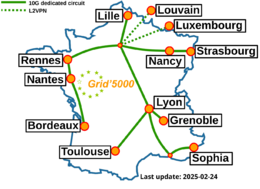Grid5000:Home
|
Grid'5000 is a precursor infrastructure of SLICES-RI, Scientific Large Scale Infrastructure for Computing/Communication Experimental Studies.
|
|
Grid'5000 is a large-scale and flexible testbed for experiment-driven research in all areas of computer science, with a focus on parallel and distributed computing, including Cloud, HPC, Big Data and AI. Key features:
Older documents:
|
Random pick of publications
Five random publications that benefited from Grid'5000 (at least 2899 overall):
- Matthieu Simonin, Anne-Cécile Orgerie. Méthodologies de calcul d'empreinte carbone sur une plateforme de calcul : exemple du site Grid'5000 de Rennes. JRES 2024 - Journées réseaux de l'enseignement et de la recherche, Renater, Dec 2024, Rennes, France. pp.1-14. hal-04893984 view on HAL pdf
- Pierre Neyron. R’n’R building of an experimentation platform for the Edge. Journée Datamove 2024, Jun 2024, Chichillianne, France. pp.1-12. hal-04604573 view on HAL pdf
- Chanattan Sok, Laurent d'Orazio, Reyyan Tekin, Dimitri Tombroff. WebAssembly serverless join: A Study of its Application. International Conference on Scientific and Statistical Database Management (SSDBM), Jul 2024, Rennes France, France. pp.1-4, 10.1145/3676288.3676305. hal-04722875 view on HAL pdf
- Alaaeddine Chaoub. Deep learning representations for prognostics and health management. Computer Science cs. Université de Lorraine, 2024. English. NNT : 2024LORR0057. tel-04687618 view on HAL pdf
- Alan Lira Nunes, Cristina Boeres, Lúcia Maria de A. Drummond, Laércio Lima Pilla. Optimal Time and Energy-Aware Client Selection Algorithms for Federated Learning on Heterogeneous Resources. 2024 IEEE 36th International Symposium on Computer Architecture and High Performance Computing (SBAC-PAD), Nov 2024, Hilo, France. pp.148-158, 10.1109/SBAC-PAD63648.2024.00021. hal-04690494v2 view on HAL pdf
Latest news
![]() Cluster "larochette" is now in the default queue in Luxembourg
Cluster "larochette" is now in the default queue in Luxembourg
We are pleased to announce that the larochette[1] cluster of Luxembourg is now available in the default queue.
Larochette is a cluster composed of 7 nodes, each with 4 MI210 AMD GPUs.
The node features:
This cluster was funded by the University of Luxembourg.
[1] https://www.grid5000.fr/w/Luxembourg:Hardware#larochette
-- Grid'5000 Team 17:46, 26 August 2025 (CEST)
The first SLICES-FR School is organized from July 7th to 11th in Lyon.
This free event, co-organized with the PEPR Cloud and Networks of the Future, brings together researchers, engineers and professionals to explore advances in distributed computing, edge computing, reprogrammable networks and the IoT.
-- Grid'5000 Team 09:30, 9 July 2025 (CEST)
![]() Cluster "vianden" is now in the default queue in Luxembourg
Cluster "vianden" is now in the default queue in Luxembourg
We are pleased to announce that the vianden[1] cluster of Luxembourg is now available in the default queue.
Vianden is a cluster of a single node with 8 MI300X AMD GPUs.
The node features:
The AMD MI300X GPUs are not supported by Grid'5000 default system (Debian 11). However, one can easily unlock full GPU functionality by deploying the ubuntu2404-rocm environment:
fluxembourg$ oarsub -t exotic -t deploy -p vianden -I
fluxembourg$ kadeploy3 -m vianden-1 ubuntu2404-rocm
More information in the Exotic page.
This cluster was funded by the University of Luxembourg.
[1] https://www.grid5000.fr/w/Luxembourg:Hardware#vianden
-- Grid'5000 Team 11:30, 27 June 2025 (CEST)
![]() Cluster "hydra" is now in the default queue in Lyon
Cluster "hydra" is now in the default queue in Lyon
We are pleased to announce that the hydra[1] cluster of Lyon is now available in the default queue.
As a reminder, Hydra is a cluster composed of 4 NVIDIA Grace-Hopper servers[2].
Each node features:
Due to its bleeding-edge hardware, the usual Grid'5000 environments are not supported by default for this cluster.
(Hydra requires system environments featuring a Linux kernel >= 6.6). The default system on the hydra nodes is based on Debian 11, but **does not provide functional GPUs**. However, users may deploy the ubuntugh2404-arm64-big environment, which is similar to the official Nvidia image provided for this machine and provides GPU support.
To submit a job on this cluster, the following command may be used:
oarsub -t exotic -p hydra
This cluster is funded by INRIA and by Laboratoire de l'Informatique du Parallélisme with ENS Lyon support.
[1] Hydra is the largest of the modern constellations according to Wikipedia: https://en.wikipedia.org/wiki/Hydra_(constellation)
[2] https://developer.nvidia.com/blog/nvidia-grace-hopper-superchip-architecture-in-depth/
-- Grid'5000 Team 16:42, 12 June 2025 (CEST)
Grid'5000 sites
Current funding
INRIA |
CNRS |
UniversitiesIMT Atlantique |
Regional councilsAquitaine |




